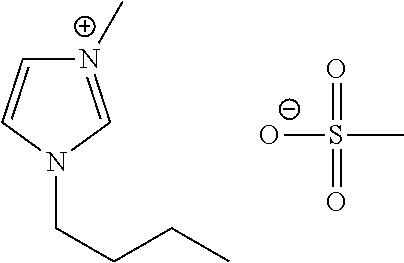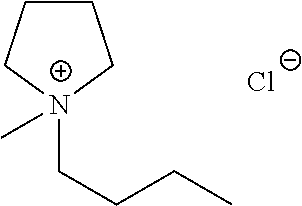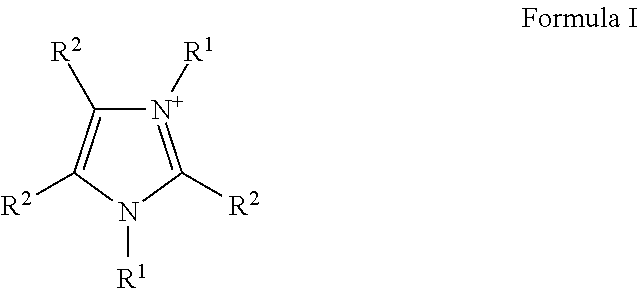Liquid protein formulations containing ionic liquids
- Summary
- Abstract
- Description
- Claims
- Application Information
AI Technical Summary
Benefits of technology
Problems solved by technology
Method used
Image
Examples
example 1
Ionic Liquids Reduce the Viscosity of Concentrated Aqueous Solutions of Biosimilar AVASTIN®
[0269]Materials and Methods
[0270]A commercially-obtained biosimilar AVASTIN® containing pharmaceutical excipients (Polysorbate 20, phosphate and citrate buffers, mannitol, and NaCl) was purified. First, Polysorbate 20 was removed using DETERGENT-OUT® TWEEN Medi Columns (G-Biosciences). Next, the resulting solutions were extensively buffer-exchanged into 20 mM sodium phosphate buffer (PB) or 20 mM viscosity-reducing ionic liquid solutions and concentrated to a final volume of less than 10 mL on Jumbosep centrifugal concentrators (Pall Corp.). For samples containing 4-ethyl-4-methylmorpholinium methyl carbonate (EMMC), protein was thoroughly buffer exchanged into 2 mM PB (pH 7.0). For samples buffer exchanged into 20 mM PB (PB control samples) or 20 mM viscosity-reducing ionic liquid, the collected protein solution was freeze-dried. The dried protein cakes, containing protein and buffer salts or...
example 2
Ionic Liquids Reduce the Viscosity of Concentrated Aqueous Solutions of Biosimilar RITUXAN®
[0273]Materials and Methods
[0274]Commercially-obtained biosimilar RITUXAN® containing pharmaceutical excipients (citrate buffer, NaCl, and Tween 80) was purified, buffer exchanged, concentrated, dried, reconstituted, and analyzed as described in Example 1 above (using the extinction coefficient of 1.7 L / g·cm). Viscosities were measured using a RheoSense mVROC microfluidic viscometer equipped with an “A” or “B” chip.
[0275]Results
[0276]The data in Table 2 demonstrate the viscosity of aqueous solutions of biosimilar RITUXAN® can be reduced by up to 8.5-fold in the presence of 0.40-0.50 M viscosity-reducing ionic liquids, compared to PB samples.
TABLE 2Viscosities (in cP) of aqueous solutions of biosimilarRITUXAN ® in the presence of various concentrationof the ionic liquid BIM at 25° C. and pH 7.[Protein]PB0.40M0.50M(mg / mL)0.25MBIMBIM213 ± 4636 ± 3275.4 ± 1.083.9 ± 0.8203 ± 4251 ± 1 65.4 ± 0.4n.d....
example 3
Ionic Liquids Reduce the Viscosity of Concentrated Aqueous Solutions of TYSABRI®
[0277]Materials and Methods
[0278]Commercially-obtained TYSABRI® containing pharmaceutical excipients (sodium phosphate buffer, NaCl, Polysorbate 80) was buffer exchanged, concentrated, dried, reconstituted, and analyzed as described in Example 1 above (using the extinction coefficient of 1.5 L / g·cm). Viscosities were measured using a RheoSense mVROC microfluidic viscometer equipped with an “A” or “B” chip.
[0279]Results
[0280]The data in Table 3 demonstrate that the viscosity of aqueous solutions of TYSABRI® can be reduced by up to 7-fold in the presence of 0.10 M EMMC.
TABLE 3Viscosities (in cP) of aqueous solutions of TYSABRI ® in thepresence of various excipients at 25° C. and pH 7.[IL][Protein]ViscosityIonic Liquid(M)(mg / mL)(cP)PB0.25237182 ± 6 Arg HCl0.25228 37 ± 0.1BIM0.423443.6 ± 1.1BMI Mes0.423235.2 ± 5.0BMP Chloride0.424942.7 ± 1.9EMMC0.123224.7 ± 0.3PB = phosphate buffer; Arg-HCl = Arginine-HCl; B...
PUM
| Property | Measurement | Unit |
|---|---|---|
| Temperature | aaaaa | aaaaa |
| Temperature | aaaaa | aaaaa |
| Weight | aaaaa | aaaaa |
Abstract
Description
Claims
Application Information
 Login to View More
Login to View More - R&D
- Intellectual Property
- Life Sciences
- Materials
- Tech Scout
- Unparalleled Data Quality
- Higher Quality Content
- 60% Fewer Hallucinations
Browse by: Latest US Patents, China's latest patents, Technical Efficacy Thesaurus, Application Domain, Technology Topic, Popular Technical Reports.
© 2025 PatSnap. All rights reserved.Legal|Privacy policy|Modern Slavery Act Transparency Statement|Sitemap|About US| Contact US: help@patsnap.com



